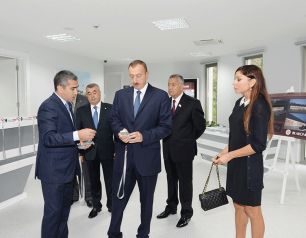
President Ilham Aliyev and Mrs Mehriban Aliyeva attend the inauguration of the Guba Genocide Memorial Complex
On September 18, the inauguration of the Guba Genocide Memorial Complex created with support from the Heydar Aliyev Foundation took place in Guba district.
President of the Republic of Azerbaijan Ilham Aliyev and Mrs Mehriban Aliyeva attended the inauguration.
The Memorial Complex has been erected in memory of tens of thousands of Azerbaijanis perished as a result of massacres committed in 1918 by Bolshevik-Armenian armed groups.
Bolshevik and Armenian armed groups have committed massacres in Baku, Guba, Shamakhy, Goychay, Javad, Salyan, Garabagh, Zangazur, Nakhchivan, Lankaran, Ganja and other districts during these events, which entered the history of Azerbaijan as one of the most tragic genocides of the 20th century, and over a thousand villages have been set on fire and destroyed. 167 villages have been completely destroyed only in Guba district during April-May 1918, while the town of Guba itself was subjected to plunders and fires, the area’s Muslim population and, partially, Jewish population have been indiscriminately killed.
The mass burial discovered in 2007 during construction works in the town of Guba is an obvious evidence of the genocide committed by Armenians in May 1918 in Guba.
With a view to delivering the facts about territorial claims and aggression policy of Armenian nationalists against Azerbaijan, preserving future generations’ national memory and eternalizing the genocide victims’ memory, by an Order of December 30, 2009, President of the Republic of Azerbaijan Ilham Aliyev resolved to create a “Genocide Memorial Complex” in the town of Guba.
Construction works carried out during 2012-2013 at the Complex being erected near the graveyard discovered in Guba has been accomplished and a rich museum created at the Memorial Complex based on historical documents and facts.
The Memorial consists of three sections: two structures resembling sharp-end knives, with entry and exit, and the main hall with a black stone in the centre. The monument has been made of concrete blocks. Any kind of decoration has been turned down to show the stillness of mourning in memory of victims of the tragedy. The sharp ends of the monument exposes the stabbing pain. The sharp ends emerging from under the ground show the impossibility if hiding the truth.
The genocide of the Muslim population in five districts of Baku province - Baku, Shamakhy, Guba, Javad and Goychay – have been reflected in the exposition of the monument-museum. Consisting of 19 sections, the museum’s exposition is presented in Azerbaijani, Russian and English languages. The exposition starts with photos reflecting the peaceful Guba on the eve of the 1918 events. Photos of old Guba, representatives of peacefully living Azerbaijani, Lezghin, Jewish and other peoples, and people related to different social strata are displayed here. The exposition is rich in unique archive documents. The Resolution of the government of the Democratic Republic of Azerbaijan on establishment of an Extraordinary Investigation Commission in order to carry out an investigation into the crime after the bloody events of 1918, documents of the Commission, a map with special content showing the territory of the Democratic Republic of Azerbaijan in 1918-1920, and the Resolution signed by national leader Heydar Aliyev on the genocide are also displayed here.
Majority of people indiscriminately killed during the acts of genocide committed in various districts have been burnt, thrown into the sea, wells, and therefore their burial was impossible. A black marble stone has been put in the centre of the hall in memory of such victims.
At the museum, every district’s historical tragedy is given with rich photo and archive documents, statistical information and diagrams. All information is given in three languages, in an electronic database.
A documentary about the Guba genocide is continuously demonstrated in the hall. The exposition is accomplished by a contemporary art peace – human faces reflected on a gigantic metal plate. This is appreciated as today’s look into the events soaked into the history’s memory, and the attitude by a modern time.
The hall’s exit is accomplished by photos reflecting the liberation of Baku by the Caucasian Islamic Army in 1918. An information centre, a rich library and a reading room equipped with computers are functioning at the Museum Complex. Our three-colour flag, the symbol of the State of Azerbaijan, has been raised in the territory of the Complex.
Delivering a speech before the general public of Guba after visiting the Museum Complex, President Ilham Aliyev talked of the acts of genocide committed against the people of Azerbaijan in the 20th century, historical facts and successful future of today’s dynamically developing Azerbaijan.
An orchard with apple trees, the symbol of Guba, has been laid out in the vast area around the Memorial. During the inauguration, President of the Republic of Azerbaijan Ilham Aliyev and Mrs Mehriban Aliyeva planted trees as a sign of respect for the genocide victims’ memory.
16 booklets and 4 books in three languages with facts evidencing the genocide committed by Armenians in 1918 in Azerbaijani districts have been published by the Heydar Aliyev Foundation.





























